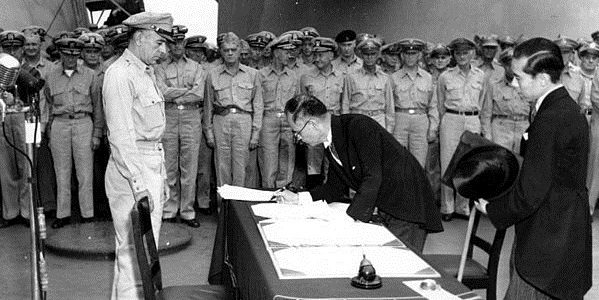 “Let us pray that peace now be restored to the world and that God will preserve it always.”
“Let us pray that peace now be restored to the world and that God will preserve it always.”
With those words spoken 71 years ago today, on September 2, 1945, Douglas MacArthur, Supreme Commander for the Allied Powers, ended World War II.
The deadliest war in human history ended with a prayer that God would preserve peace throughout the world.
General MacArthur offered that prayer during a formal signing ceremony on board the USS Missouri. Leading members of Allied powers were there, as well as official delegates from Japan. The Japanese were there to sign the official “Instrument of Surrender.”
One month earlier, the United States dropped atomic bombs on Hiroshima and Nagasaki, “killing at least 129,000 people” and causing nuclear devastation to the Japanese people for future generations.
I appreciate MacArthur’s prayers for peace. I believe in God. But the truth is that peace is not God’s responsibility. It is ours.
General MacArthur began his speech saying, “It is my earnest hope, and indeed the hope of all mankind, that from this solemn occasion a better world shall emerge out of the blood and carnage of the past.”
Unfortunately, peace has been elusive for humanity. We continue to hope that peace will emerge from war, from “the blood and carnage of the past.” Walter Wink calls this idea the “myth of redemptive violence.” Violence can never bring peace. It brings a cycle of violence. What matters is that someone stop the cycle of violence.
People often ask, “But what about World War II?” It seems that General MacArthur was right. After WWII, Germany and Japan turned from being bitter enemies to becoming close friends with the Allied powers. Did violence and war bring about their conversion? Can violence be redemptive?
Lessons from WWI
It was not war, blood, and carnage that fostered peace during the aftermath of WWII. It was what happened after the WWII that led to peace. But first, it’s important to learn from the lessons of WWI.
World War I ended with multiple peace treaties, but the most important was the Treaty of Versailles. The buildup to WWI was a long and complicated series of violent events between nations. History shows that no country was completely innocent, thus, no country was completely guilty. Each side of that war claimed that the other side started the hostilities. And each side was correct.
The Treaty of Versailles created “peace” between the Allied powers and Germany. The treaty forced Germany to “accept the responsibility of Germany and her allies for causing all the loss and damage” of the war. Known as the “War Guilt Clause,” it demanded that Germany disarm, concede substantial territory, and pay reparations to countries damaged by the war.
Germans largely felt blamed and humiliated by the treaty. Anger and resentment grew among the population. English economist John Maynard Keynes, the world’s foremost economist during this period, opposed the harsh financial penalty to the German economy and warned about the treaty’s effect upon the nation. Moreover, Keynes boldly stated that the Allies weren’t motivated by peace, “The future life of Europe was not their concern,” he wrote in chapter IV of his document “The Economic Consequences of the Peace.” Rather, they were motivated in part by “revenge, and to the shifting by the victors of their unbearable financial burdens on to the shoulders of the defeated.”
Germans felt punished and shamed by the treaty. It planted the seeds of hostility and resentment. It brought a social crisis, which helped create the conditions for the rise of Adolf Hitler.
Saving Face: Lessons Learned
Let’s go back to September 2, 1945. Onboard the USS Missouri, the Japanese dignitaries didn’t know exactly what to expect. Were the Americans going to blame them the way they blamed Germany after WWI?
But General MacArthur learned from the lessons of history. A better world between the United States and Japan didn’t emerge from a past of bloodshed and carnage. It emerged from allowing the defeated Japanese to “save face.” Instead of shaming the Japanese people, MacArthur stated, “I announce it my firm purpose to proceed in the discharge of my responsibilities with justice and tolerance.”
According to Tom Brokaw, the phrase “justice and tolerance” brought a spirit of peace to the relationship between the Japan and the Allied powers. One Japanese dignitary responded to those words by saying they assuaged Japanese anxiety and transformed the deck of the Missouri into an “altar of peace.”
The “blood and carnage” of war didn’t bring peace. Economic revenge didn’t bring peace. Rather, justice and tolerance are the sisters of peace. Economic justice following WWII didn’t primarily involve punishing the Japanese economy, thus shaming the Japanese people. Rather, it involved helping the Japanese economy. Instead of crippling the Japanese economy by enforcing reparations, the US invested $2.2 billion into the Japanese reconstruction efforts. And Japan, largely due to Japanese economic policies and its own people, grew to become the world’s second largest economy.
Lessons for Today
The events before and after WWI and WWII are long and complicated, with mixed motivations on every side. Unfortunately, the blood and carnage of WWII led to the nuclear standoff of the Cold War. Winning the cold war didn’t bring peace, either. Current events show that we humans have a long way to go if we are to learn the ways of peace.
But the events on the USS Missouri have important lessons for us that we need to remember. As we fight the “War on Terror,” it’s important to realize that the “altar of peace” cannot be built by bombs, drones, and the violence of war. Nor can it be built by shared hatred against a common enemy or a future of assigning shame, blame, and guilt.
Peace can only be built by allowing one another to save face. We need to have the humility to admit that our face needs saving, too. For it is in the face of our fellow human beings, including those we call our enemies, where we find our shared humanity and the possibility of a more peaceful future.
Image: Wikimedia, Public Domain, Japanese Foreign Minister Mamoru Shigemitsu signing the Instrument of Surrender on behalf of the Japanese Government, formally ending World War II. Some changes made.











